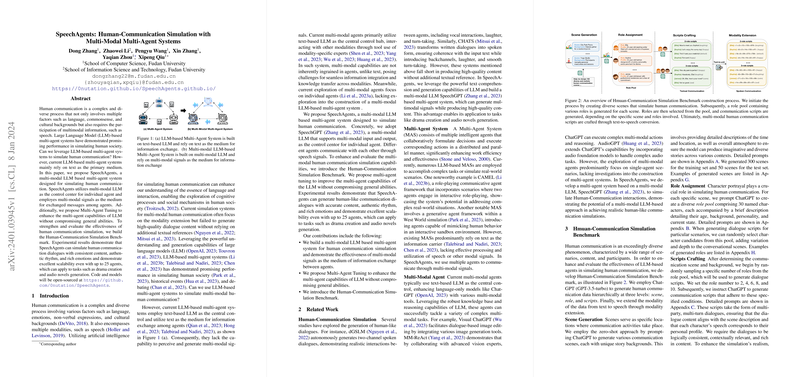Overview of "SpeechAgents: Human-Communication Simulation with Multi-Modal Multi-Agent Systems"
The paper "SpeechAgents: Human-Communication Simulation with Multi-Modal Multi-Agent Systems" presents an ambitious approach for simulating human communication by employing a multi-modal LLM based multi-agent system. The primary goal is to advance beyond current LLM-based multi-agent systems that are traditionally text-focused, by incorporating multi-modal signals, specifically speech, as a medium for communication.
Core Contributions
The authors introduce SpeechAgents, a system designed to simulate human interactions through multi-modal exchanges. The system employs SpeechGPT, a variant of multi-modal LLM that supports both input and output in different modalities, as the core of individual agents. This choice allows the agents to interact naturally by passing speech signals instead of merely textual ones.
Furthermore, they propose a novel technique called Multi-Agent Tuning. This method tailors the LLM to bolster its multi-agent capabilities without detracting from its general competencies. This is crucial as it enables the system to retain its broad-based linguistic abilities while optimizing for specific task-oriented performance.
To evaluate the system’s capabilities, the authors introduce the Human-Communication Simulation Benchmark, a comprehensive dataset crafted to test the effectiveness of simulated human communication through diverse scenarios. This benchmark evaluates the system based on the accuracy and authenticity of the simulated dialogue content and its scalability across the number of interacting agents.
Experimental Findings
The paper’s experimental results reveal that SpeechAgents can generate dialogues exhibiting resonant human-like qualities in terms of content consistency, rhythm, and emotional richness. The system demonstrates robustness in scalability, maintaining its performance integrity even with up to 25 agents engaged in a session, showcasing its potential for complex tasks like drama creation and audio novel generation. This aspect is critical, emphasizing the applicability and integration potential of this system in entertainment and interactive media domains.
Additionally, the paper notes a significant advantage of utilizing multi-modal signals, a departure from traditional text-only systems. This transition not only enhances the realism of interactions but also opens up new avenues for integrating cross-modal knowledge, relying on the seamless transfer of information between modalities within the agents.
Implications and Future Directions
The implications of this research are two-fold: practically, it aligns AI systems closer to human communication paradigms by leveraging speech as an interaction medium—a crucial step for applications in virtual interactions, automated storytelling, and educational technologies. Theoretically, it sets a precedent for the scalability of multi-agent systems by integrating advanced LLMs capable of handling multi-modal interactions.
For future developments, this work suggests broader exploration into employing more complex and varied multi-modal inputs and further refinement of multi-agent tuning methodologies. The potential integration of additional sensory modalities like visual signals could lead to even more sophisticated simulations, offering greater depth and realism in artificial intelligence-led interactions.
Conclusion
This paper presents a significant stride toward merging the advanced linguistic capacities of LLMs with multi-modal communication frameworks, facilitating a more holistic simulation of human-like interaction. As AI continues to evolve, systems like SpeechAgents pave the way for increasingly dynamic and integrated applications, promising to revolutionize how machines understand and mimic human communication. The groundwork laid by this research fosters numerous possibilities, marking an incremental but pivotal step in the development of multi-modal, multi-agent systems.
